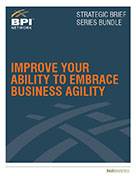Thought Leadership
Programs Background

Predictability Through Planning Agility
Best Practices in Collaborative Budgeting and Continuous Business Rebalancing
Improving the accuracy, value and efficiency of financial planning, forecasting and budgeting should be an important goal for any organization. Research shows companies that are adept in these processes outperform their competition. Yet financial processes and systems frequently lack the agility and responsiveness to keep pace with changing business needs and developments. Budgeting is often excessively time-consuming and arduous, while the final product is typically out-of-date on arrival. Financial planning processes should, but often do not, motivate and drive organizational performance. There is a real need for greater timeliness and frequency in budgeting and forecasting with new systems and processes that can improve planning flexibility, speed, and accuracy. Companies need to determine how they can increase collaboration and the value of financial planning across the entire organization.
Through the “Predictability Through Planning Agility” program, the Business Performance Innovation Network will investigate how organizations can make financial processes more relevant in driving organizational excellence, efficiency and decision dexterity, while improving forecasting and budgeting accuracy. The program will look at the value and limitations of corporate financial forecasting and budgeting processes and discuss the right practices and approaches for improving the performance management aspects of financial processes.
Reports

This report investigates how organizations can make financial processes more relevant in driving organizational excellence, efficiency and informed decision-making, while improving forecast and budget accuracy.
Download »

Improving the accuracy, value and efficiency of financial planning, forecasting and budgeting should be an important goal for any organization. Research shows companies that are adept in these processes outperform their competition. Yet financial processes and systems frequently lack the agility and responsiveness to keep pace with changing business needs and developments. Budgeting is often excessively time-consuming and arduous, while the final product is typically out-of-date on arrival. Financial planning processes should, but often do not, motivate and drive organizational performance.
Download »

Download the entire series of four strategic briefs on improving the accuracy, value and efficiency or financial planning & budgeting.
Download »
Leaders

Managing Director of Strategy
Accenture

Chief Financial Officer
American Internet Services

Head of Corporate Finance
Grant Thornton

Senior Director of Financial Planning and Analytics
Jazz Pharmaceuticals

Chief Financial Officer of IT
Kaiser Permanente

Chief Financial Officer
Powerlinx

Vice President of Finance
SciClone Pharmaceuticals

Professor of Finance
Stanford University

Senior Vice President, Finance
Welch Allyn
Facts & Stats
Companies that successfully addressed their planning and forecasting issues saw an average share price growth of 116% over three years, 221% over five years, and 373% over ten years. (Source)
The average corporation spends four months and 20-30% of senior executives’ and financial managers’ time on the budget. (Source)
Companies using spreadsheets for treasury reporting spend an average of 1.8 hours per day on manual and operational tasks, compared with 1.3 hours per day for those with a treasury platform. A few spreadsheet users (6%) spend more than five hours on reporting daily. (Source)
Forecasts and budgets are often innaccurate. Despite technological advances, most organizations use a patchwork of spreadsheet models to undertake their forecasting budgeting, with multiple hand-offs and revisions throughout the process. Inaccuracies arise due to lack of version control, transposition of numbers and unallocated numbers with aggregated data not equaling the sum of their parts. (Source)
The budget process for lower-quartile companies takes longer than six months. Similarily, $1 billion companies take, on average, 25,000 man days to complete their budget. (Source)
The acquisition strategy that brought the biggest benefits in 2013 to SaaS small busineses is customer/user referrals (17.2%) (Source)
Only 6% of 300 CIO's and IT professionals said they would never move systems to the cloud. (Source)
The top business process area that needs technology investment is to facilitate analysis and decision making (59%, up from 57% in 2012), followed by the ongoing monitoring of business performance (50%), and then collaboration and knowledge management (45%, down from 52% in 2012). (Source)
34% of Asia Pacific IT industry executives plan to increase their budgets in SaaS and public cloud within 2013 and 2014. (Source)
48 percent of the treasurers and CFOs want SaaS technology to allow them to have better technology and tools. (Source)
Articles
July 4, 2015 - 9 Money Lessons in Baseball
CNN Money
Read more »
July 2, 2015 - 31 Ways Financial Planners Can Make You Richer
Go Banking Rates
Read more »
April 15, 2014 - Cloud Computing Enables Businesses to Discover Their Entrepreneurial Spirit
The Guardian
Read more »
March 24, 2014 - H-P's Tech Revamping Begins to Pay Off
Wall Street Journal
Read more »
March 21, 2014 - The cloud continues to kick Oracle's butt -- but not just in technology
CITEworld
Read more »
August 16, 2013 - CFOs moving past data privacy objections to cloud-based software
TechTarget
Read more »
June 5, 2013 - Oracle Customers Must ‘Consider All Available Options’
Wall Street Journal
Read more »
March 13, 2013 - Head of IT at Pandora urges IT to embrace cloud applications
TechTarget
Read more »
October 4, 2012 - Corporations looking to the cloud to lower IT costs, replace legacy systems
TechJournal
Read more »
February 20, 2009 - Hello, Financial SaaS; Good-bye, IT
BusinessFinance
Read more »
White Papers
Financial Planning: Realizing the Value of Budgeting and Forecasting
Managing business performance in today’s complex and rapidly changing business climate is crucial for any organization’s short-term and long-term success. Read more »
The Cloud Changing the Business Ecosystem
Cloud Computing, popularly known as ‘the Cloud’, promises to change the face of Information Technology (IT) as we know it today. Read more »
Sponsor

Host Analytics is the leader in cloud-based financial applications for planning, close management, reporting, and analytics.
Visit website »
Events

Keeping Business in Balance
On Demand | Online
Today’s senior FP&A executives are facing a critical need to provide a more responsive, flexible and continuous planning, budgeting and forecasting process that will allow them to adapt to changing market conditions and opportunities, which will enable their financial planning to become more relevant and valuable to business outcomes. In this thought leadership webinar we will look at the organizational roadblocks and challenges that are keeping the financial planning function from delivering greater business and decision-making value across the organization and hear from leading executives on how to implement new thinking and processes.
Event website »



 Share
Share